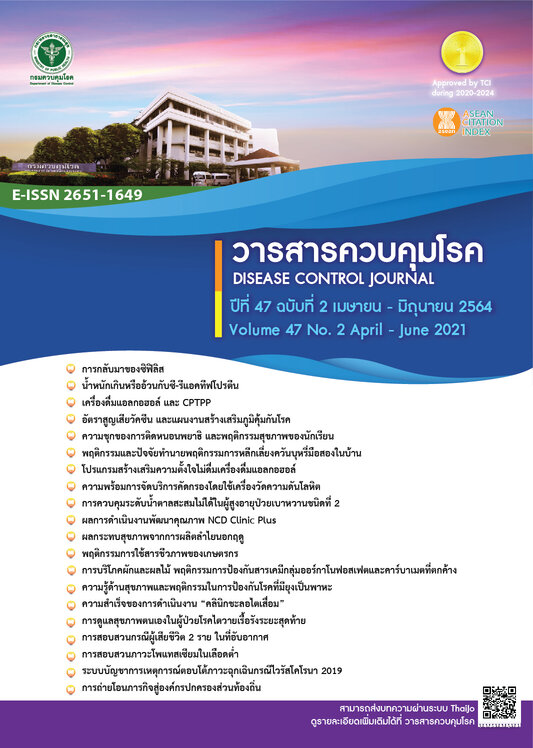Individuals with overweight and obesity are firmly associated with high-risk level of C-reactive protein
DOI:
https://doi.org/10.14456/dcj.2021.19Keywords:
C-reactive protein, biomarker, risk factor, overweight and obesityAbstract
Objective: High sensitivity C-reactive protein (hs-CRP) is a biomarker useful for health screening for body inflammation. The study to determine the association between clinical risks and hs-CRP level in the Thai cohort is limited. This study aimed to determine the association between clinical factors and hs-CRP level. Materials and Methods: This study was a cross-sectional, analytic, observational study. The results of high sensitivity C-reactive protein (hs-CRP) level of the participants visiting health care check-up clinic at Mae Fah Luang University Hospital were collected. Clinical demographics, past medical history, laboratory testing, and anthropometric measurements on the same day of hs-CRP blood draw were reviewed and collected. Results: The prevalence rate of high-risk hs-CRP was 46.1%. The clinical factors including age, gender, abnormal hematologic parameters, metabolic syndrome, lipid profiles, and HbA1C level were not different between the two groups. Based onmultivariate andlogistic regression model, people with BMI > 25.0 kg/m2 significantly demonstrated 5.14 times greater to have high-risk hs-CRP (hs-CRP>3.0 mg/L) than those with BMI < 25.0 kg/m2. Conclusion: Individuals with overweight and obesity or BMI > 25.0 kg/m2 are associated with high-risk levels of hs-CRP. The recommendation to add hs-CRP level to the package of annual health check-up is required.
Downloads
References
National Statistical Office. Demography Population and Housing Branch [Internet]. 2020 [cited 2020 Mar 15]. Available from: http://statbbi.nso.go.th/staticreport/page/sector/th/01.aspx
World Health organization. Noncommunicable diseases [Internet]. 2018 [cited 2020 Mar 15]. Available from: https://www.who.int/news-room/fact-sheets/detail/noncommunicable-diseases
Thakur JS, Jeet G, Nangia R, Singh D, Grover S, Lyngdoh T, et al. Non-communicable diseases risk factors and their determinants: A cross-sectional state-wide STEPS survey, Haryana, North India. PLoS One. 2019;14(11):e0208872.
Skevaki C, Van den Berg J, Jones N, Garssen J, Vuillermin P, Levin M, et al. Immune biomarkers in the spectrum of childhood noncommunicable diseases. J Allergy Clin Immunol. 2016;137:1302-16.
Ganguly P, Alam SF. Role of homocysteine in the development of cardiovascular disease. Nutr J. 2015;14:6.
Maruyama K, Shiga T, Iijima M, Moriya S, Mizuno S, Toi S, et al. Brain natriuretic peptide in acute ischemic stroke. J Stroke Cerebrovasc Dis. 2014;23:967-72.
Yeh ET, Willerson JT. Coming of age of C-reactive protein: using inflammation markers in cardiology. Circulation. 2003;107:370-1.
Sabatine MS, Morrow DA, Jablonski KA, Rice MM, Warnica JW, Domanski MJ, et al. Prognostic significance of the Centers for Disease Control/American Heart Association high-sensitivity C-reactive protein cut points for cardiovascular and other outcomes in patients with stable coronary artery disease. Circulation. 2007;115:1528-36.
Chong Y, Ren Q, Li Y, Li C, Feng F, Zhou Y. Biomarkers for Prediction of Cardiovascular Events in Community-Dwelling Adults Aged 40 or Older. Int Heart J. 2020;61:109-14.
Purohit A, Ghilchik MW, Duncan L, Wang DY, Singh A, Walker MM, et al. Aromatase activity and interleukin-6 production by normal and malignant breast tissues. J Clin Endocrinol Metab. 1995;80:3052-8.
Mohamed-Ali V, Goodrick S, Rawesh A, Katz DR, Miles JM, Yudkin JS, et al. Subcutaneous adipose tissue releases interleukin-6, but not tumor necrosis factor-, in vivo. J Clin Endocrinol Metab. 1997;82:4196-200.
Banks RE, Forbes MA, Storr M, Higginson J, Thompson D, Raynes J, et al. The acute phase response in patients receiving subcutaneous IL-6. Clin Exp Immunol. 1995;102:217-23.
Papanicolaou DA, Wilder RL, Manolagas SC, Chrousos GP. The pathophysiologic roles of interleukin-6 in human disease. Ann Intern Med. 1998;128:127-37.
Danesh J, Collins R, Appleby P, Peto R. Association of fibrinogen, C-reactive protein, albumin, or leukocyte count with coronary heart disease: meta-analyses of prospective studies. JAMA. 1998;279:1477-82.
Ridker PM, Buring JE, Shih J, Matias M, Hennekens CH. Prospective study of C-reactive protein and the risk of future cardiovascular events among apparently healthy women. Circulation. 1998;98:731-3.
Koenig W, Sund M, Fröhlich M, Fischer HG, Löwel H, Döring A, et al. C-reactive protein, a sensitive marker of inflammation, predicts future risk of coronary heart disease in initially healthy middle-aged men. Circulation. 1999;99:237-42.
Visser M, Bouter LM, McQuillan GM, Wener MH, Harris TB. Elevated C-reactive protein levels in overweight and obese adults. JAMA. 1999;282:2131-5.
Ding D, Wang M, Su D, Hong C, Li X, Yang Y, et al. Body Mass Index, High-Sensitivity C-Reactive Protein and Mortality in Chinese with Coronary Artery Disease. PLoS One. 2015;10(8):e0135713.
Farooq SN, Ahmed A, Mustufa MA, Rizvi MI, Serafi AH, Khan AA. High Sensitivity C-Reactive Protein Level Increases with Rise in Body Mass Index and not Affected by Perceived Stress in Young Saudis. Annals of Medical and Health Sciences Research. 2017;7:224-9.
Lin CC, Kardia SL, Li CI, Liu CS, Lai MM, Lin WY, et al. The relationship of high sensitivity C-reactive protein to percent body fat mass, body mass index, waist-to-hip ratio, and waist circumference in a Taiwanese population. BMC Public Health. 2010;10:579.
Downloads
Published
How to Cite
Issue
Section
License
Articles published in the Disease Control Journal are considered as academic work, research or analysis of the personal opinion of the authors, not the opinion of the Thailand Department of Disease Control or editorial team. The authors must be responsible for their articles.






